
Located in the Wakayama Prefecture, about 60km south of Osaka, Kōya-san is home to an active monastic community established over twelve centuries ago for the study and practice of Esoteric Buddhism. The priest Kukai (posthumously known as Kobo Daishi) founded the monastery deep in the mountains, far away from worldly distractions, so that Buddhist monks could practice their faith in peace and tranquillity. After the hustle and bustle of Tokyo and Kyoto, it was therefore a perfect place for Paul and I to relax for a couple of days.
Don’t let the distance put you off. Yes, it takes three separate train rides and (surely) one of the steepest funiculars in the world to reach, but the journey isn’t stressful (travelling in Japan is a dream)…and trust me, the effort will be rewarded. Kōya-san truly is a secluded sanctuary, nestled away in a highland valley between eight mountains (often likened to the eight petals of a lotus flower) and with one of the most stunning collection of buildings you’ll find in the whole country. It’s film-set like perfection is a living postcard for Japan.

I loved the place instantaneously…despite the incessant grey drizzle that greeted us. And was super excited to check in to Eko-in, our temple lodgings for the night.
Dosho, one of Kobo Daishi’s disciples, built Eko-in 1,100 years ago as a place for calm reflection. ‘Eko’ meaning “bless the light”. I felt more relaxed straight away, as one of the resident monks guided us to our traditional washitsu room, complete with tatami flooring and fusuma sliding doors, where green tea and nibbles were waiting for us. The space was only around 10 square metres, and would be where we ate, slept and relaxed for the next 36 hours; the monks changing our furniture around according to the time of day. The only snag: communal bathrooms and toilets were a fair walk down the hall…a good job we would be abstaining from alcohol for the duration!
After fortifying ourselves with the sweet sesame buns, and refusing to let the rain hold us back, we borrowed a couple of ubiquitous large, translucent brollies from the monks and set out to explore the hillside retreat. Kōya-san is only 4km east-to-west and 2km north-to-south, so easily navigable on foot and perfectly do-able in such a short break.
We headed first to Dai Garan, the second most important area of Kōya-san after the cemetery (more on which later): ‘Dai’ meaning great and ‘Garan’ deriving from the Sanskrit for a quiet and secluded place (you see a theme developing, I hope). The area is made up of four main buildings: the Konpon Daito (Great Pagoda), Kondo (Golden Hall), Fudodo (the oldest extant building in Kōya-san, now designated a national treasure) and the Miedo (Portrait Hall). Now, a confession: we did return to this beautiful place the following day, when the sun was out and there wasn’t a cloud in the sky, so I’m cheating and posting mainly photos from that second day.

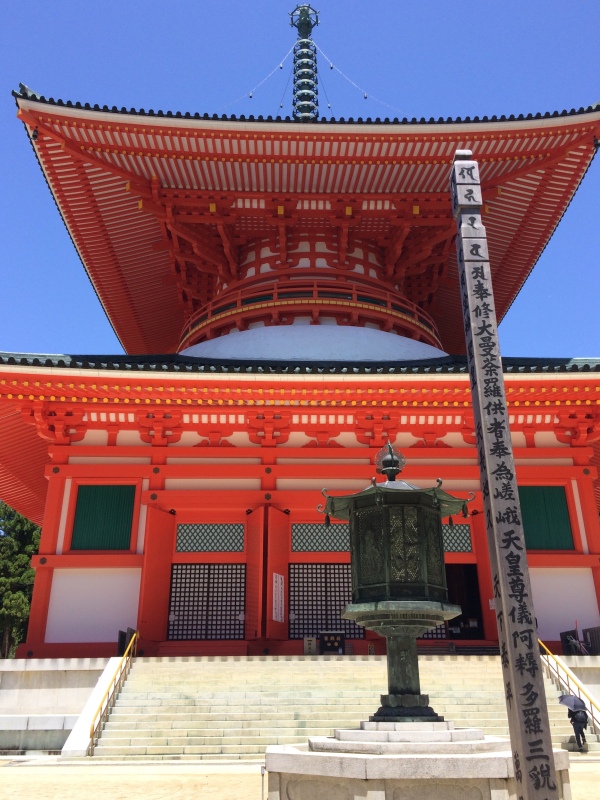
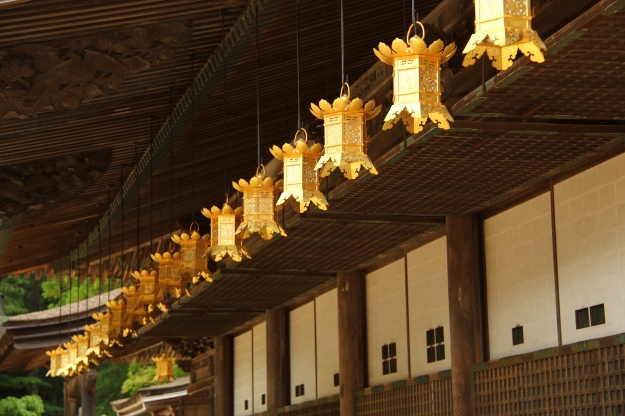
Kobo Daishi is said to have planned the Great Pagoda as the centre of the whole monastic complex. It took seventy years to build – ultimately having to be completed by his disciple Shinzen – and, at almost 50m high, it’s a magnificent construction. The Konpon has, though, been destroyed by lightning strikes and fire five separate times, so the structure you see today is far from original. Eventually, when sense prevailed (and the appropriate building materials became available), it was re-constructed in ferroconcrete with wooden overlays, to try to avoid the problem happening again. Fingers crossed!
The whole area is quite magical, with moss covered torii gates, dragon guardians, and ancient wooden halls bedecked with lanterns. You’re also more likely to see pilgrims (passing through on the Kii Mountain route) than you are tourists, which is very pleasant indeed.

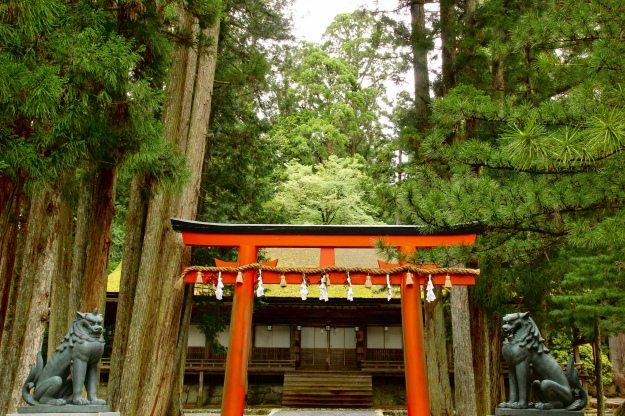

Given we were close, we also visited Rokkaku Kyozo, a hexagonal sutra repository that houses a complete copy of the Buddhist scriptures in gold ink; as well as Kongobuji temple, the headquarters of Shingon Buddhism. I think this latter temple might have my favourite rock garden in Japan (a close call: lots of strong contenders). It certainly holds the prize for being biggest, at over 2,000 square metres; the 140 pieces of granite having been dragged to Mount Kōya from Shikoku and the white sand all the way from Kyoto. The resulting rock formations in Banryutei garden are designed to resemble dragons emerging from a sea of clouds. Enchanting. It’s always so tempting to sneakily create new patterns in the sand…but the stern-faced gardeners were unlikely to have found this amusing.
The temple also has one of my favourite interiors: the intricately painted sliding doors in the Yanagi-No-Ma (Willow Room) and in front of the Buddha hall depict the four seasons, as well as cranes, rivers and the surrounding landscape, all in beautiful lacquer.
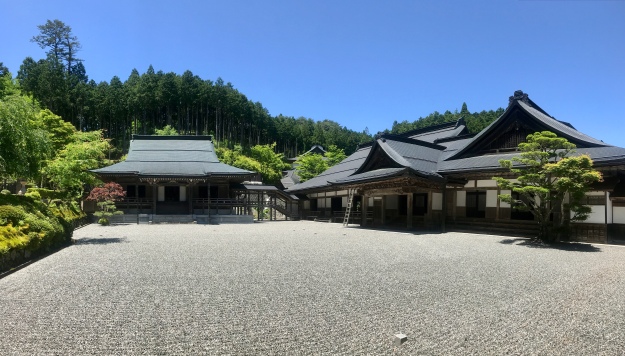
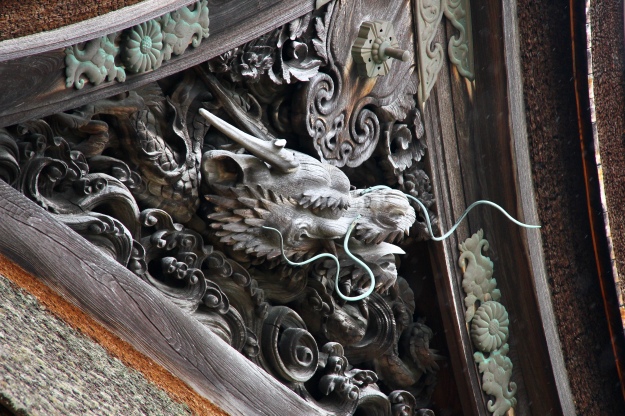
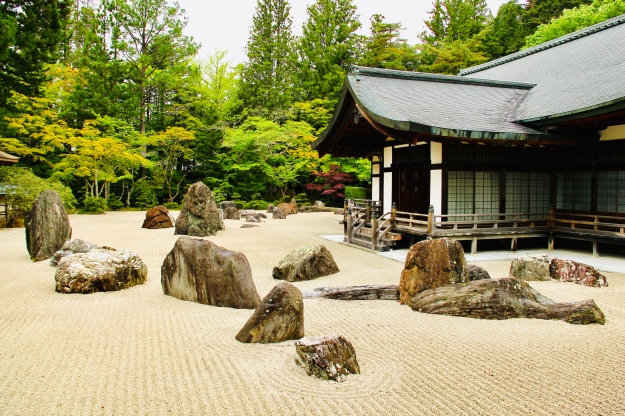
Back at Eko-in, we changed out of wet clothes and attended a meditation with Moshi, one of the resident monks. There are 117 temples in Koyasan, 52 of which are set up as lodgings; and the main reason to stay in one is to take part in the various ceremonies, rituals and meditations alongside the monks. This afternoon’s session was a Ajikan meditation: contemplation of the Sanskrit letter “A”, which is drawn on the image of the moon. The letter “A” represents the Cosmic Sun Buddha, Dainichi Nyorai, and the purpose of the meditation is to make the practitioner and the Sun Buddha become one. Posture is extremely important: you need to sit with your legs crossed and ideally your knees touching the ground, your thumbs touching and your hands making a circle. You must thrust out your stomach and hold it in tension, whilst at the same time relaxing all other parts of your body, and your eyes should be neither open nor closed, in order to watch both the external and internal world at the same time. It’s bloody difficult.
Back in our washitsu room, we enjoyed a traditional Buddhist vegetarian dinner (Shojin-Ryori – see my blog 29 Seasons of Tofu for a full account of this delicious meal) before heading out with Moshi for a nighttime tour of Okunoin, the largest cemetery in Japan. There are more than 200,000 graves in Okunoin, and walking through it in the dark is an atmospheric – if not downright spooky – experience. There are no dead in the cemetery, it is said: only waiting spirits. And Kobo Daishi himself has not passed on; he took himself into the woods on the mountainside towards the end of his life and is there still to this day, meditating for eternity behind a closed gate. The community’s head monk takes him a meal every day and is the only one allowed to go through the gate (I’m not able to confirm, but I suspect this monk is quite portly). But one day – so the apocalyptic prophecy goes – Kobo Daishi will finish his meditation, and it is then that all the souls “resting” in the graves will rise up.
Moshi guided us along rain-shimmering trails, past tall cedar trees and moss covered tombs, stone lanterns casting their glow and lighting our way. He pointed out the five pillars of Buddhism in structural form (earth, space, wind, fire and water) which sit alongside our consciousness; and explained how Shintoism and Buddhism have come together in Japan, which is why you often find Shinto shrines within temple complexes. We were also told to note the numerous depictions of Jizō Buddha, the guardian of youth and patron deity of deceased children and aborted fetuses. He’s usually represented as a small, cheery looking dude, and worshippers tend to knit little hats and clothes to adorn his statues. I later learned, however, that Jizō is also regarded as the Bodhisattva of hell-beings…so felt a little less warmly towards him after that.


We followed the path through the forest and up to Kukai Mausoleum, a very sacred place where no food can be consumed and no photos taken. Once you cross the Gobyo no Hashi bridge, we were told, you have entered a higher level of the sacred. At this point, you must throw water over one of the Buddha statues lining the route, cleansing yourself for the journey ahead. Preferable, we quickly decided, to the original ritual of bathing in the freezing mountain stream.
The mausoleum is a stunningly beautiful hall, flanked by the Toro-do lantern pavilion. Legend has it that some of the gold lanterns have been burning continuously for 1,000 years. Around the back is a giant lantern with gold lotus flowers. This is the innermost sanctum, where the gate behind which Kobo Daishi meditates can be found. Moshi paused here to recite a sutra, and whilst he chanted I stared around is awe, thinking myself very privileged to see such a special place.
Making our own way back to Eko-in, we lost the crowd and took time to absorb the place, wandering the dark trails alone. Maybe a little too contemplative, since we only just made it back to the temple in time for the 9pm curfew, apologising to the waiting monks for our tardiness. Slinking back to our room and dressing in traditional yukata, we hung out playing card games for a while, but – knowing we’d be up at 6:10am for morning meditation – hit the hay quite quickly.
Waking to the sounds of monks chanting in the main temple hall, we joined our fellow lodgers for the first of the day’s ceremonies. I can’t pretend to know what this one was about, but there was cymbal clashing, repetition of a low, humming mantra, and an iron pot was hit several times; then we were invited to light incense and quietly shuffle in a circle around the hall, bowing to Buddha. Moving on to a second temple building, we were next invited to join the Gomakito (Homa fire ritual).

This ceremony is unique to Vajrayana and Esoteric Buddhism and is considered one of the most cognitively powerful. It is performed by consecrated priests and acharyas (religious instructors) for the benefit of either individuals, the state at large, or indeed all sentient beings. The fire is believed to have a powerful cleansing effect, both spiritually and psychologically; the ritual destroys negative energies, detrimental thoughts and desires, and bestows blessings. We were told to write a prayer/wish on a wooden stick, which was later thrown into the fire, along with seeds tossed by our acharya. He also splashed the flames with liquid, fanned the fire and rubbed (what looked like) rosary beads, whilst other monks chanted and banged a taiko drum. At the ritual’s climax, we were invited to waft smoke from the fire onto parts of our body that might be in pain. It was certainly dramatic…and incredibly smoky!
Our futons had been removed while we were gone, so with no chance to returning to sleep we had a quick dip in the public baths (Paul reporting that the men were much more reserved than the women) and then revisited the cemetery. It was great to experience it in a whole new light – and a particularly glorious, blue skied light at that. A completely different atmosphere to the preceding evening.
Having exhausted the delights of Okunoin, we caught a local bus up to the imposing Daimon gate at the edge of town, walking back through the village to revisit Dai Garan and stop for a casual lunch of katsu and donburi. Just time for a quick kimono purchase, from an elderly lady on the main drag, before catching the funicular back to the station. Onward to Osaka…
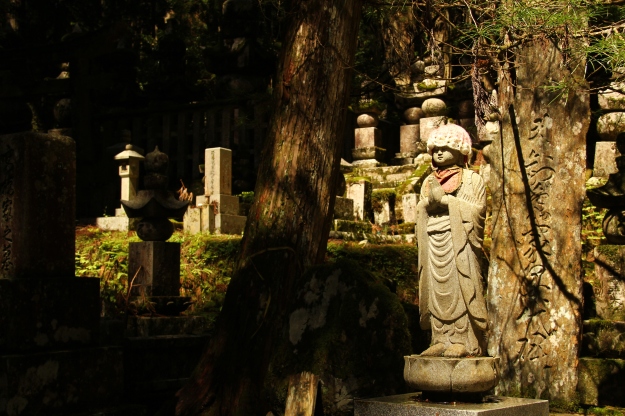



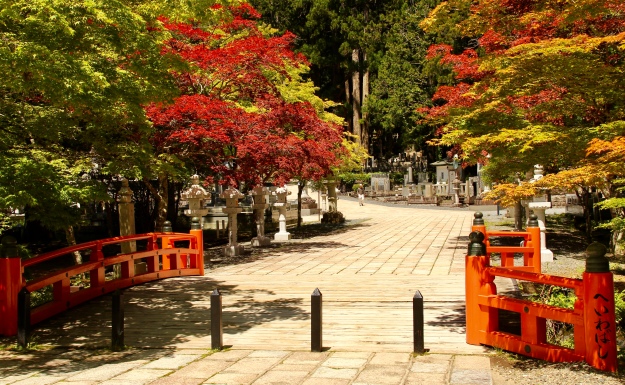
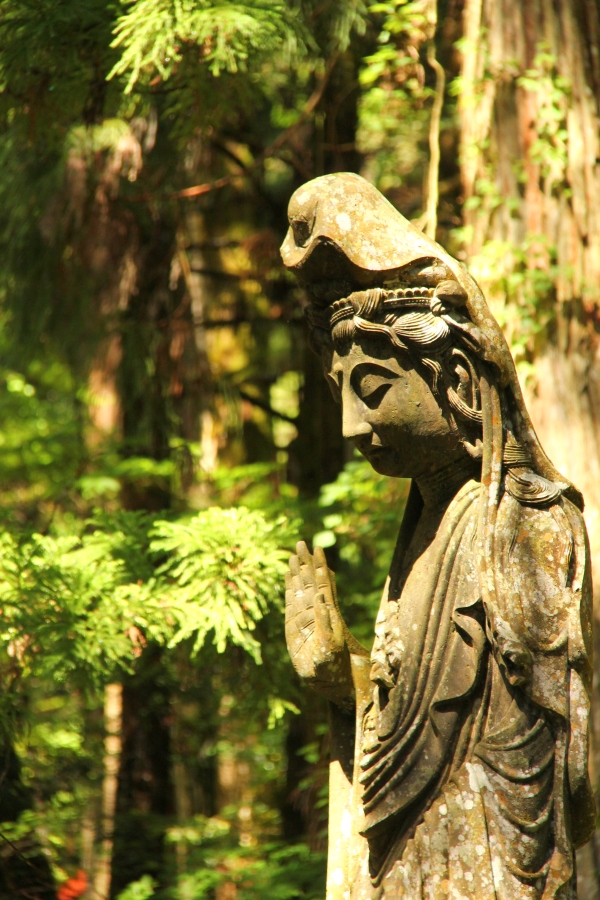


Pingback: The Legacy of Little Boy | Victoria's Secret Blog